Question
Case: Nike, Inc. Cost of Capital Case requirements: Rewrite the memorandum in Exhibit 5. Include the answers to the following questions in your analysis. 1.
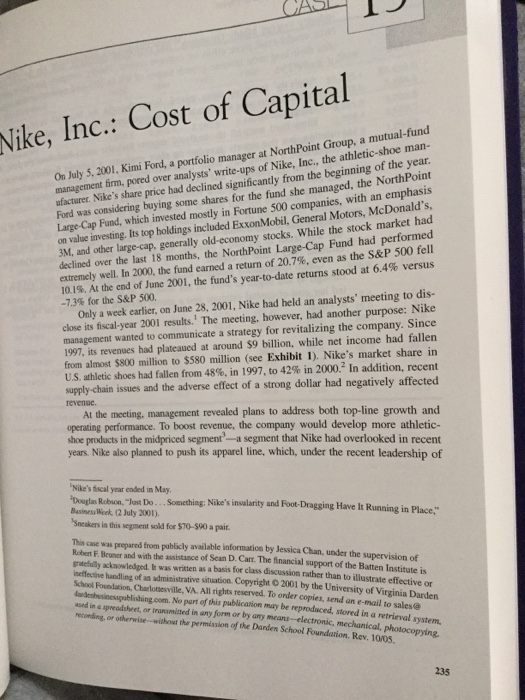
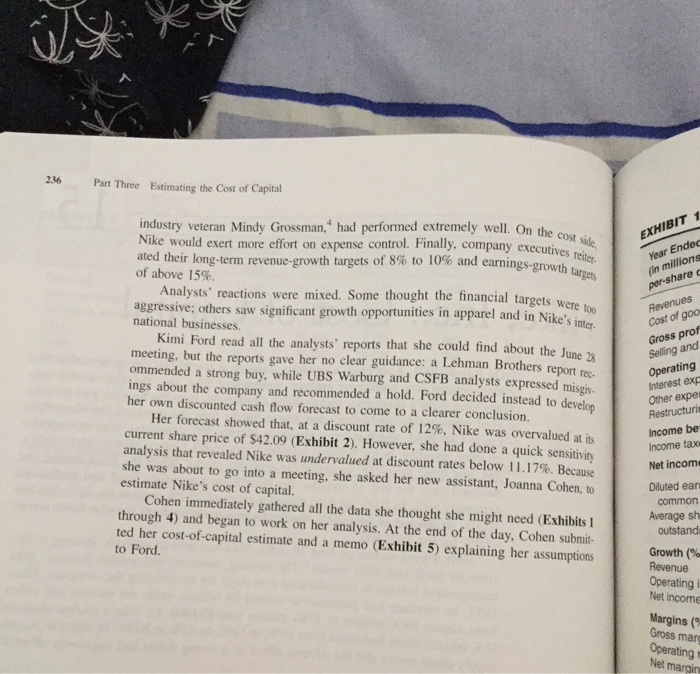
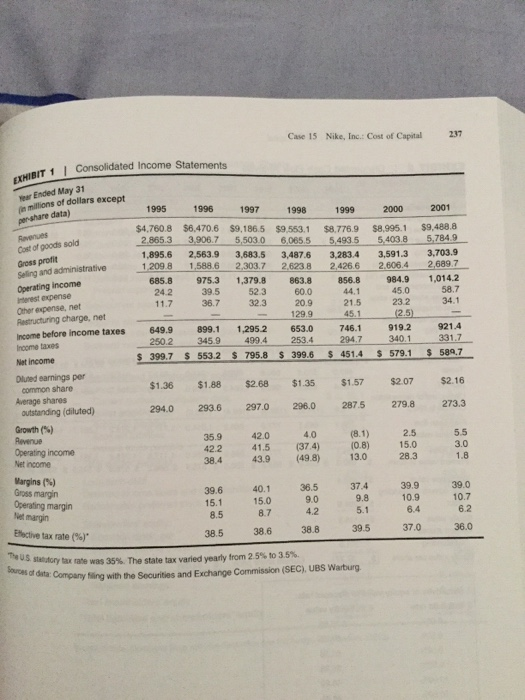

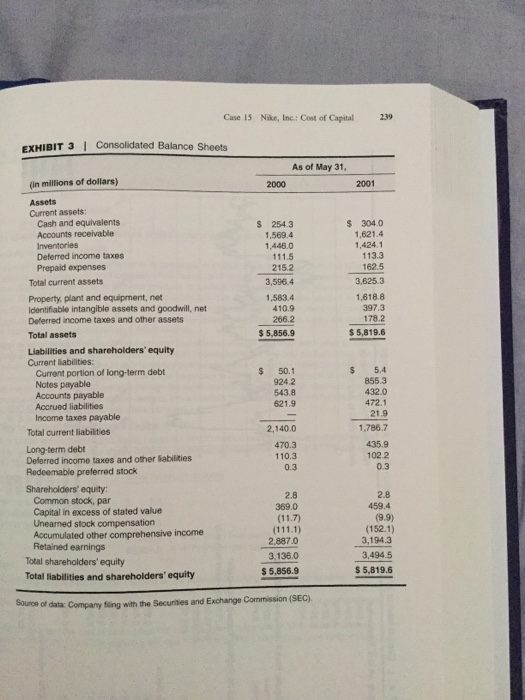
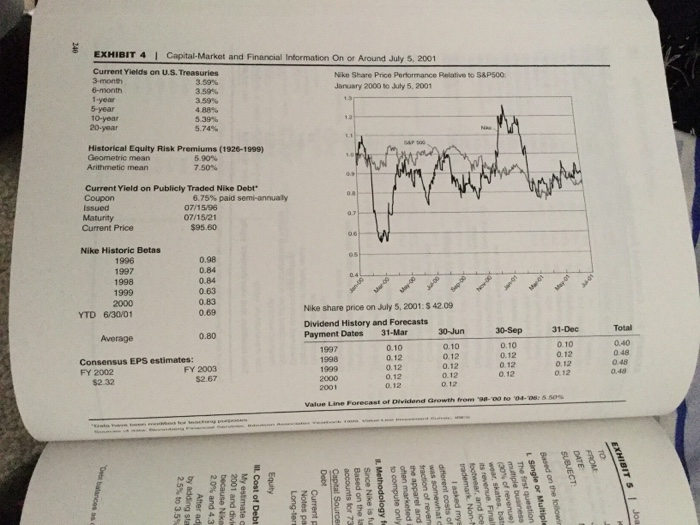
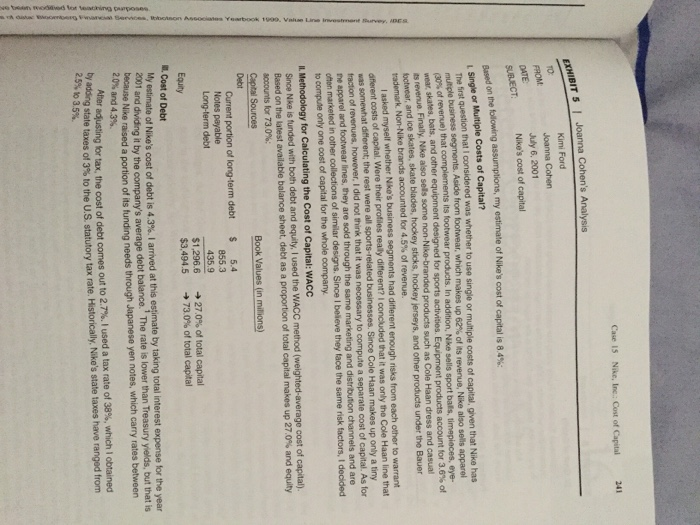

Case: Nike, Inc. Cost of Capital
Case requirements: Rewrite the memorandum in Exhibit 5. Include the answers to the following questions in your analysis.
1. What is the WACC and why is it important to estimate a firms cost of capital? What does it represent? Is the WACC set by investors or by managers?
2. Do you agree with Joanna Cohens WACC calculation? Why or why not?
3. If you do not agree with Cohens analysis, calculate your own WACC for Nike and be prepared to justify your assumptions. What mistakes did Joanna Cohen make in her analysis?
4. Calculate the costs of equity using CAPM and the dividend discount model. What are the advantages and disadvantages of each method?
5. What should Kimi Ford recommend regarding an investment in Nike? With your WACC estimation, what is Nikes stock price? How does the market price compare to your stock price estimation?
Nike, Inc.: Cost of Capital ual-fund On July 5, 2001, Kimi Ford, a portfolio manager at NorthPoint Group management firm, pored over analysts' write-ups of Nike, Inc., the athletic-shoe man- afacturer. Nike's share price had declined significantly from the beginning of the year. Ford was considering buying some shares for the fund she managed, the NorthPoint Large -Cap Fund, which invested mostly in Fortune 500 companies, with an emphasis on value investing. Its top holdings included ExxonMobil, General Motors, McDonald's, 3M, and other large-cap, generally old-economy stocks. While the stock market had declined over the last 18 months, the NorthPoint Large-Cap Fund had performed extremely well. In 2000, the fund earned a return of 207%, even as the S&P 500 fell 10.1%. At the end of June 2001, the fund's year-to-date returns stood at 6.4% versus -73% for the S&P 500. Only a week earlier, on June 28, 2001, Nike had held an analysts' meeting to dis- close its fiscal-year 2001 results. The meeting, however, had another purpose: Nike management wanted to communicate a strategy for revitalizing the company. Since 1997, its revenues had plateaued at around S9 billion, while net income had fallen from almost $800 million to $580 million (see Exhibit 1). Nike's market share irn U.S. athletic shoes had fallen from 48%, in 1997, to 42% in 2003 In addition, recent supply-chain issues and the adverse effecet of a strong dollar had negatively affected revenoc. At the meeting, management revealed plans to address both top-line growth and operating performance. To boost revenue, the company would develop more athletic- shoe products in the midpriced segment-a segment that Nike had overlooked in recent years Nike also planned to push its apparel line, which, under the recent leadership of Nike's fiscal year ended in May Douglas Robson. Jast Do... Something: Nike's insalarity and Foot-Dragging Have It Running in Place." Basiness Week, (2 July 2001). Sneakers in this segment sold for $70-$90 a pair This case was prepared from pablicly available information by Jessica Chan, under the supervision of Robert F. Bruner and with the assistance of Sean D. Car. The financial support of the Batten Institute is gratefully acknowledged. It was written as a basis for class discussion rather than to illustrate effective or School Foundation,Charlotesville, VA. All rights reserved. To order copies, send an e-mail to sales@ administrative situation Copyright 2001 by the University of Virginia Darden ased in a spreodsheet, or trarsmitted in any form or by ary meanu-electronic, mechanical, photocopying reconding, or otherwise without the permission of the Darden School Foundation. Rev. 1005. system. 235 Nike, Inc.: Cost of Capital ual-fund On July 5, 2001, Kimi Ford, a portfolio manager at NorthPoint Group management firm, pored over analysts' write-ups of Nike, Inc., the athletic-shoe man- afacturer. Nike's share price had declined significantly from the beginning of the year. Ford was considering buying some shares for the fund she managed, the NorthPoint Large -Cap Fund, which invested mostly in Fortune 500 companies, with an emphasis on value investing. Its top holdings included ExxonMobil, General Motors, McDonald's, 3M, and other large-cap, generally old-economy stocks. While the stock market had declined over the last 18 months, the NorthPoint Large-Cap Fund had performed extremely well. In 2000, the fund earned a return of 207%, even as the S&P 500 fell 10.1%. At the end of June 2001, the fund's year-to-date returns stood at 6.4% versus -73% for the S&P 500. Only a week earlier, on June 28, 2001, Nike had held an analysts' meeting to dis- close its fiscal-year 2001 results. The meeting, however, had another purpose: Nike management wanted to communicate a strategy for revitalizing the company. Since 1997, its revenues had plateaued at around S9 billion, while net income had fallen from almost $800 million to $580 million (see Exhibit 1). Nike's market share irn U.S. athletic shoes had fallen from 48%, in 1997, to 42% in 2003 In addition, recent supply-chain issues and the adverse effecet of a strong dollar had negatively affected revenoc. At the meeting, management revealed plans to address both top-line growth and operating performance. To boost revenue, the company would develop more athletic- shoe products in the midpriced segment-a segment that Nike had overlooked in recent years Nike also planned to push its apparel line, which, under the recent leadership of Nike's fiscal year ended in May Douglas Robson. Jast Do... Something: Nike's insalarity and Foot-Dragging Have It Running in Place." Basiness Week, (2 July 2001). Sneakers in this segment sold for $70-$90 a pair This case was prepared from pablicly available information by Jessica Chan, under the supervision of Robert F. Bruner and with the assistance of Sean D. Car. The financial support of the Batten Institute is gratefully acknowledged. It was written as a basis for class discussion rather than to illustrate effective or School Foundation,Charlotesville, VA. All rights reserved. To order copies, send an e-mail to sales@ administrative situation Copyright 2001 by the University of Virginia Darden ased in a spreodsheet, or trarsmitted in any form or by ary meanu-electronic, mechanical, photocopying reconding, or otherwise without the permission of the Darden School Foundation. Rev. 1005. system. 235Step by Step Solution
There are 3 Steps involved in it
Step: 1

Get Instant Access to Expert-Tailored Solutions
See step-by-step solutions with expert insights and AI powered tools for academic success
Step: 2

Step: 3

Ace Your Homework with AI
Get the answers you need in no time with our AI-driven, step-by-step assistance
Get Started


